Demolition Contractors Minooka
Top Demolition Company Near Me in Minooka
Get multiple Demolition Companies quotes for your project today! Compare profiles, reviews, accreditations, portfolio, etc... and choose the best service.
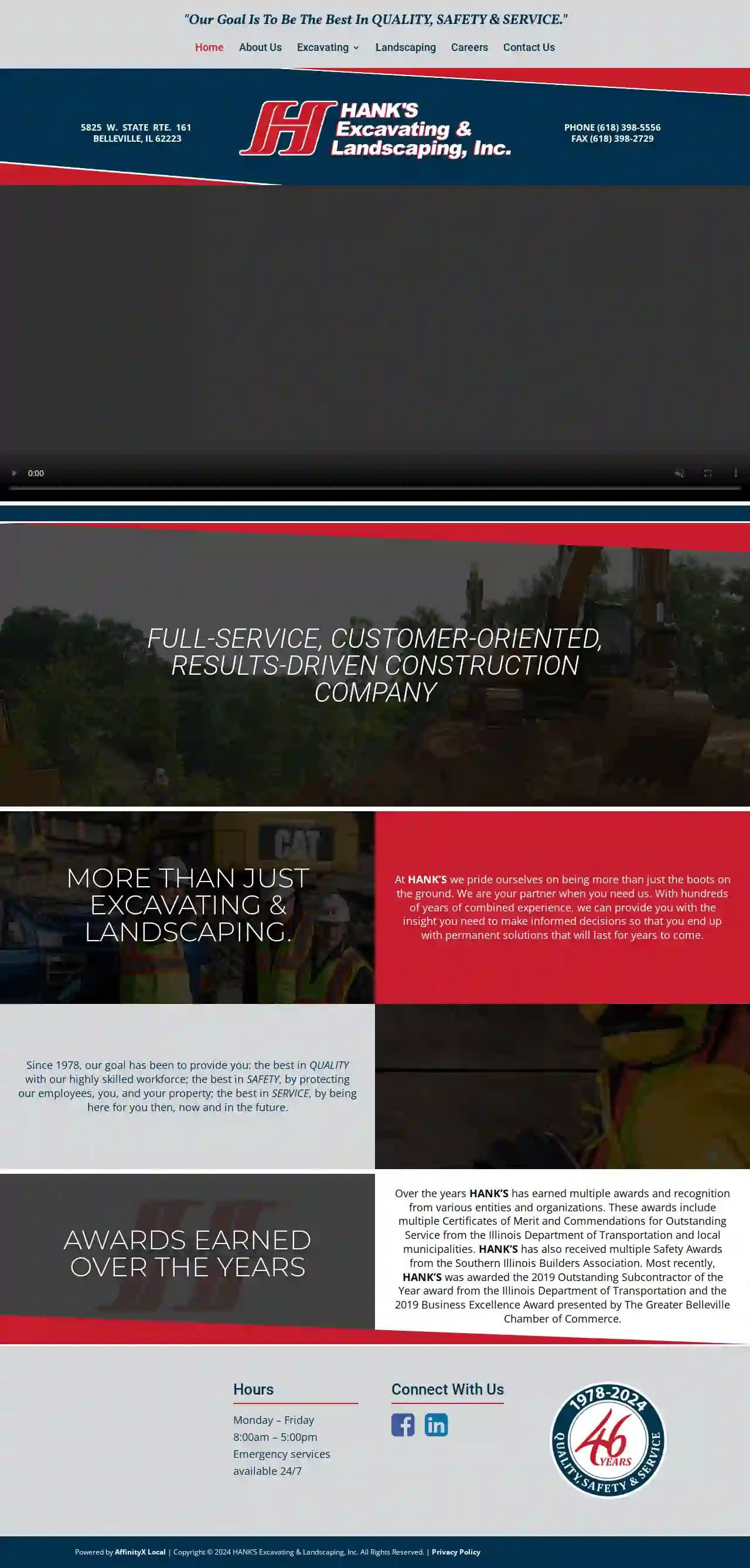
Hank's Excavating & Landscaping Inc
315 reviews5825 W. State Rt. 161, Belleville, 62223, USMore than just Excavating & Landscaping. At HANK’S, we pride ourselves on being more than just the boots on the ground. We are your partner when you need us. With hundreds of years of combined experience, we can provide you with the insight you need to make informed decisions so that you end up with permanent solutions that will last for years to come. Since 1978, our goal has been to provide you: the best in QUALITY with our highly skilled workforce; the best in SAFETY, by protecting our employees, you, and your property; the best in SERVICE, by being here for you then, now and in the future. Building the project is only one aspect of what we do Since 1978, our goal has been to provide you: the best in QUALITY with our highly skilled workforce; the best in SAFETY, by protecting our employees, you, and your property; the best in SERVICE, by being here for you then, now and in the future. Awards earned over the years Over the years HANK’S has earned multiple awards and recognition from various entities and organizations. These awards include multiple Certificates of Merit and Commendations for Outstanding Service from the Illinois Department of Transportation and local municipalities. HANK’S has also received multiple Safety Awards from the Southern Illinois Builders Association. Most recently, HANK’S was awarded the 2019 Outstanding Subcontractor of the Year award from the Illinois Department of Transportation and the 2019 Business Excellence Award presented by The Greater Belleville Chamber of Commerce.
- Services
- Why Us?
- Gallery
Get Quote
J.G Gagnon & Son's Excavation L.L.C
44 reviewsEpping, New Hampshire, United States, USJ.G. GAGNON & SON’S EXCAVATION L.L.C. We take pride in all the jobs we do. With 30 years of experience and pristine work ethics, we give every customer and job 200%. We have a passion, not only for the excavation work itself but, for our customers and their satisfaction! We treat and tackle every job as if it was our own. We take extreme pride in our finished product, always leaving our customers completely satisfied. We’re a small business located in Southern NH and offer services in -
- Services
- Why Us?
- Gallery
Get Quote
Wilder Excavating LLC
52 reviews126 Kennedy Brook Drive, Stoddard, 03464-4514, USWelcome to Wilder Excavating! Located in Southwestern NH, Wilder Excavating is a locally family-owned business serving the Monadnock Region and surrounding areas. We work with both residential and commercial customers. At Wilder Excavating, we take great pride in our hands-on experience, expertise, quality, and customer service. It is our mission to provide excellent workmanship and complete customer satisfaction from the start to finish of your project. We understand every customer has different needs. We take time to meet with you, evaluate your project and give you options based on your needs and budget. We take great care to work and communicate with every customer in a professional manner. Our reputation is based on service, safety, and quality, regardless of how large or small the job. Ben from Wilder excavating is nothing short of a solid human being. I have used them multiple times for material sourcing, material delivery, heavy equipment trucking, and advice so I can plan for future projects. Never once was there an issue with any of our interactions regardless of the amount of money changing hands. I recommend them to anyone I know in the region that needs their many services. - Eddie FREE ESTIMATES Need a new lawn, driveway, culvert, septic system … or something needing an excavator… and have no idea what to budget? We are happy to come to you to evaluate the job, and give you pricing… with NO OBLIGATION on your part to hire us for the job. Depending on your needs, we will often give additional options… which you may not have thought about to make the end project better and still be within or under a price range that will fit your budget. We stand behind our work and our pricing. Financing options are available for qualified individuals, if needed. Call for a FREE ESTIMATE (603) 313-5591
- Services
- Why Us?
- Testimonials
- Gallery
Get Quote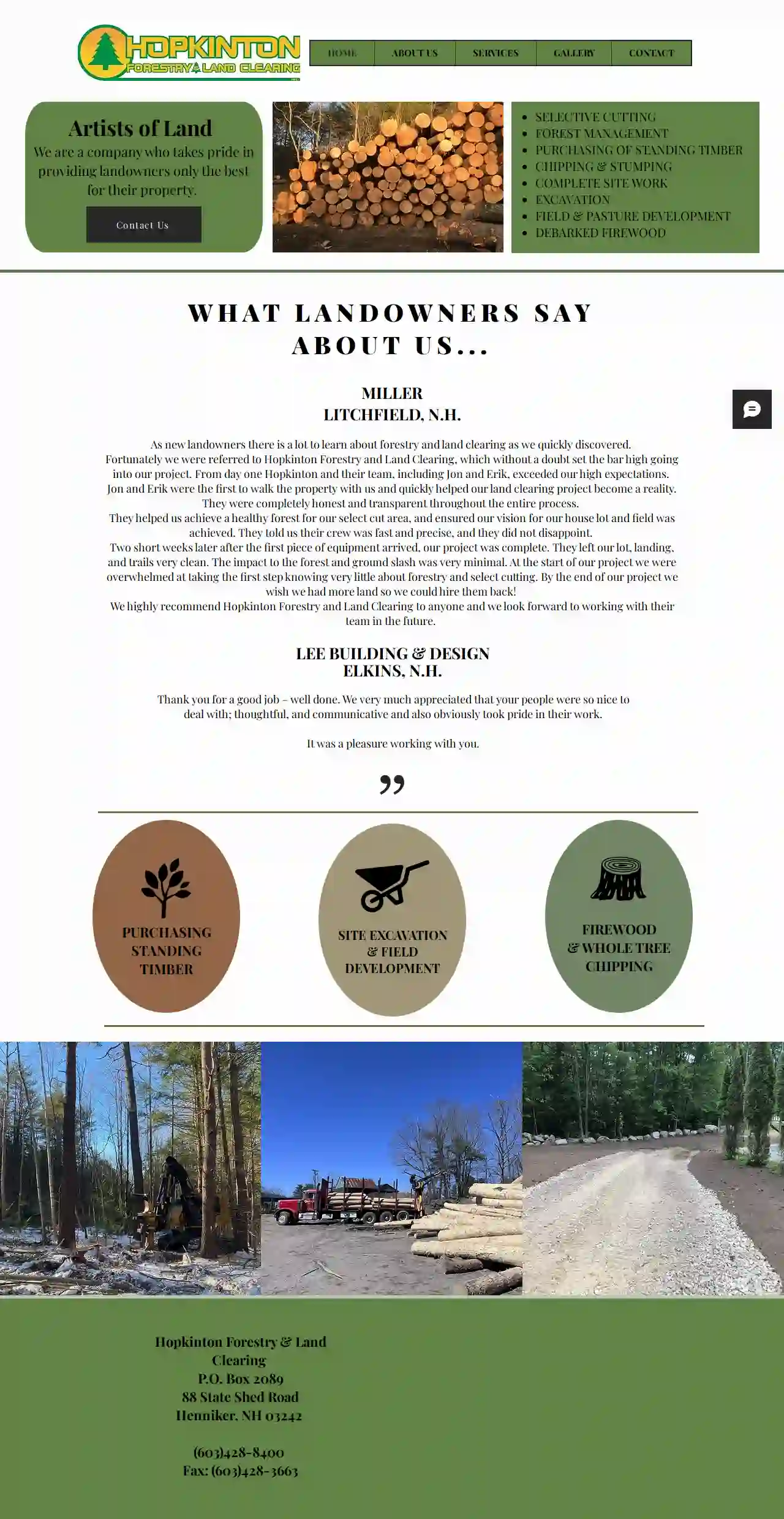
Hopkinton Forestry & Land Clr
52 reviewsP.O. Box 2089, 88 State Shed Road, Henniker, 03242, USArtists of Land We are a company who takes pride in providing landowners only the best for their property. As new landowners there is a lot to learn about forestry and land clearing as we quickly discovered. Fortunately we were referred to Hopkinton Forestry and Land Clearing, which without a doubt set the bar high going into our project. From day one Hopkinton and their team, including Jon and Erik, exceeded our high expectations. Jon and Erik were the first to walk the property with us and quickly helped our land clearing project become a reality. They were completely honest and transparent throughout the entire process. They helped us achieve a healthy forest for our select cut area, and ensured our vision for our house lot and field was achieved. They told us their crew was fast and precise, and they did not disappoint. Two short weeks later after the first piece of equipment arrived, our project was complete. They left our lot, landing, and trails very clean. The impact to the forest and ground slash was very minimal. At the start of our project we were overwhelmed at taking the first step knowing very little about forestry and select cutting. By the end of our project we wish we had more land so we could hire them back! We highly recommend Hopkinton Forestry and Land Clearing to anyone and we look forward to working with their team in the future. Thank you for a good job – well done. We very much appreciated that your people were so nice to deal with; thoughtful, and communicative and also obviously took pride in their work. It was a pleasure working with you.
- Services
- Why Us?
- Testimonials
- Gallery
Get Quote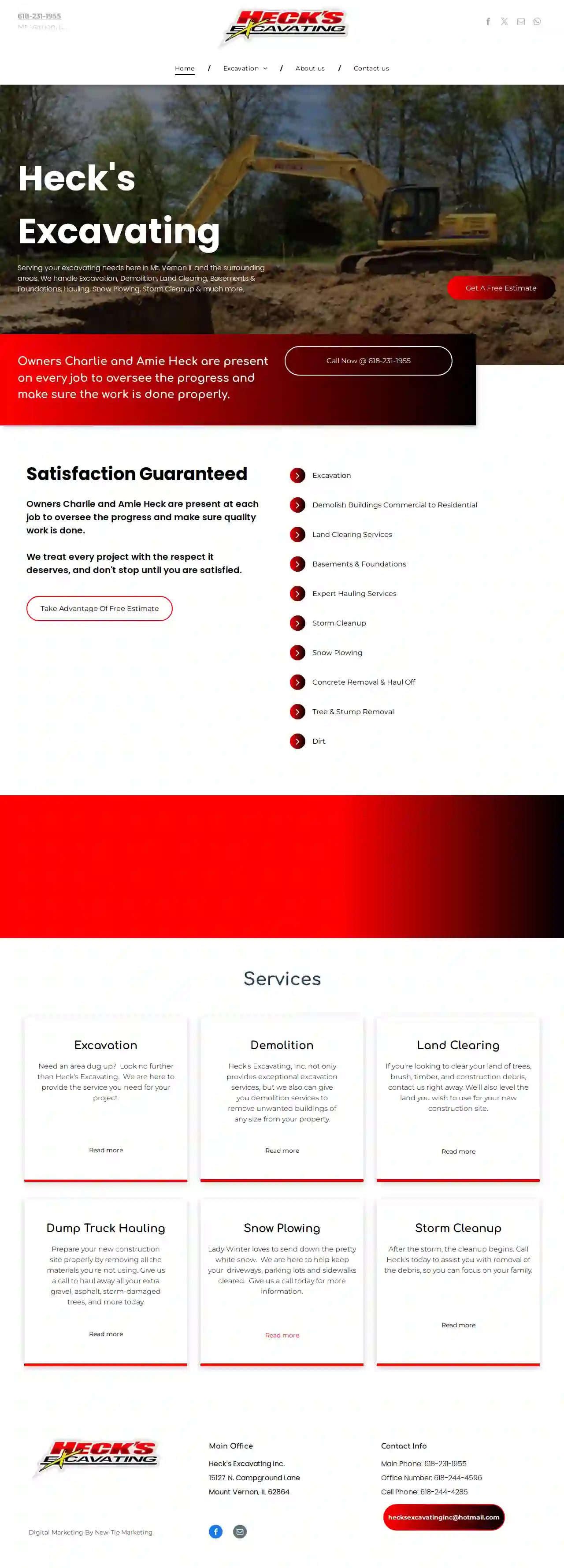
Heck’s Excavating
15127 N. Campground Lane, Mount Vernon, 62864, USHeck's Excavating: Your Trusted Partner for Excavation and More Heck's Excavating Inc. has been serving the Mt. Vernon, IL area and surrounding communities since 2009. We are a family-owned business dedicated to providing high-quality excavation, demolition, and other services with a commitment to customer satisfaction. Our Commitment to Quality Owners Charlie and Amie Heck are personally involved in every project, ensuring that every job is completed to the highest standards. We believe in treating every project with the respect it deserves, and we don't stop until you are completely satisfied. A Wide Range of Services From excavation and demolition to land clearing, basement and foundation work, hauling, snow plowing, and storm cleanup, Heck's Excavating is your one-stop shop for all your project needs. We are equipped to handle projects of all sizes, both residential and commercial. Experience the Heck's Difference We take pride in our work and treat every job as if it were our own home or office. Our commitment to quality, service, and customer satisfaction sets us apart. Choose Heck's Excavating for a reliable and trustworthy partner for your next project.
- Services
- Why Us?
- Our Team
- Gallery
Get Quote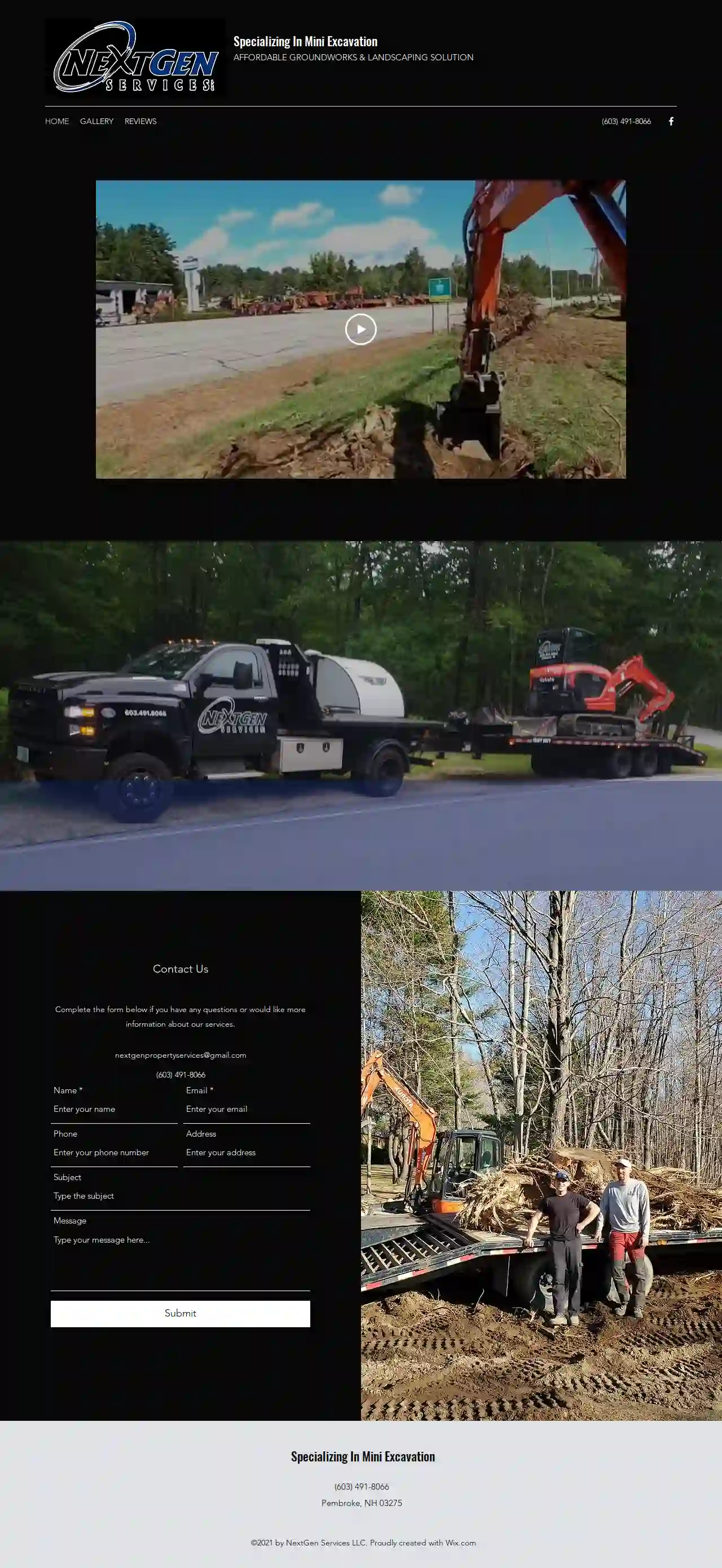
NextGen Services LLC
4.99 reviewsPembroke, 03275, USNextGen Property Services NH NextGen Property Services NH is a local business specializing in mini excavation and offering a wide range of groundworks and landscaping solutions. We are committed to providing affordable and high-quality services to our clients in Pembroke, NH and surrounding areas. Our team is dedicated to delivering exceptional results, exceeding expectations, and building lasting relationships with our clients. We take pride in our meticulous attention to detail and our commitment to customer satisfaction. Whether you need land clearing, stump removal, landscaping, parking pad construction, conduit trenching, estate cleanouts, brush removal, loam and mulch deliveries, or equipment transportation, we have the expertise and resources to handle your project efficiently and effectively. Contact us today to discuss your needs and receive a free estimate.
- Services
- Why Us?
- Gallery
Get Quote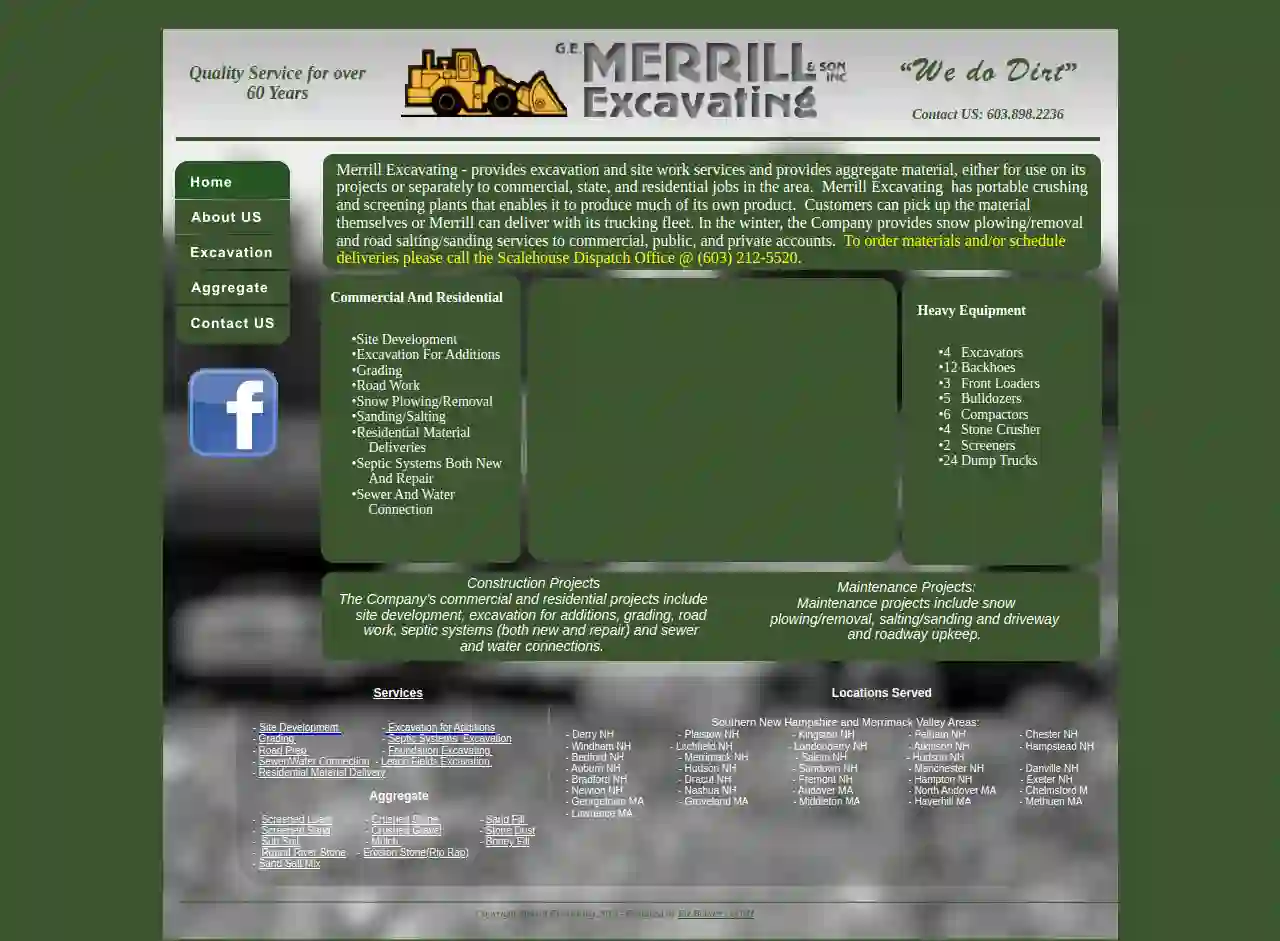
Merrill Excavating
425 reviews38 School Street, Salem, 03079, USMerrill Excavating - Quality Since 1953! Over the past 60 years Merrill Excavating has evolved with the needs of our community and its people. Our commitment keeps our business both a leader and trusted name in our local community. History George E. Merrill founded the company in 1953 with humble beginnings - one tractor and one employee. Under his direction and determined efforts, the company would grow to become an essential member of the local construction community. In 1980, his son George D. took over the company and started to expand its products and services to meet the changing needs of its growing community and customer base. Since George D. Merrill's retirement, his sons Gary and Jonathan have run the company, which now has over 45 employees and a large inventory of equipment suited to any job, large or small. The company also has a sand and gravel pit located in Salem, NH. To order materials and/or schedule deliveries please call the Scalehouse Dispatch Office @ (603) 212-5520.
- Services
- Why Us?
- Gallery
Get Quote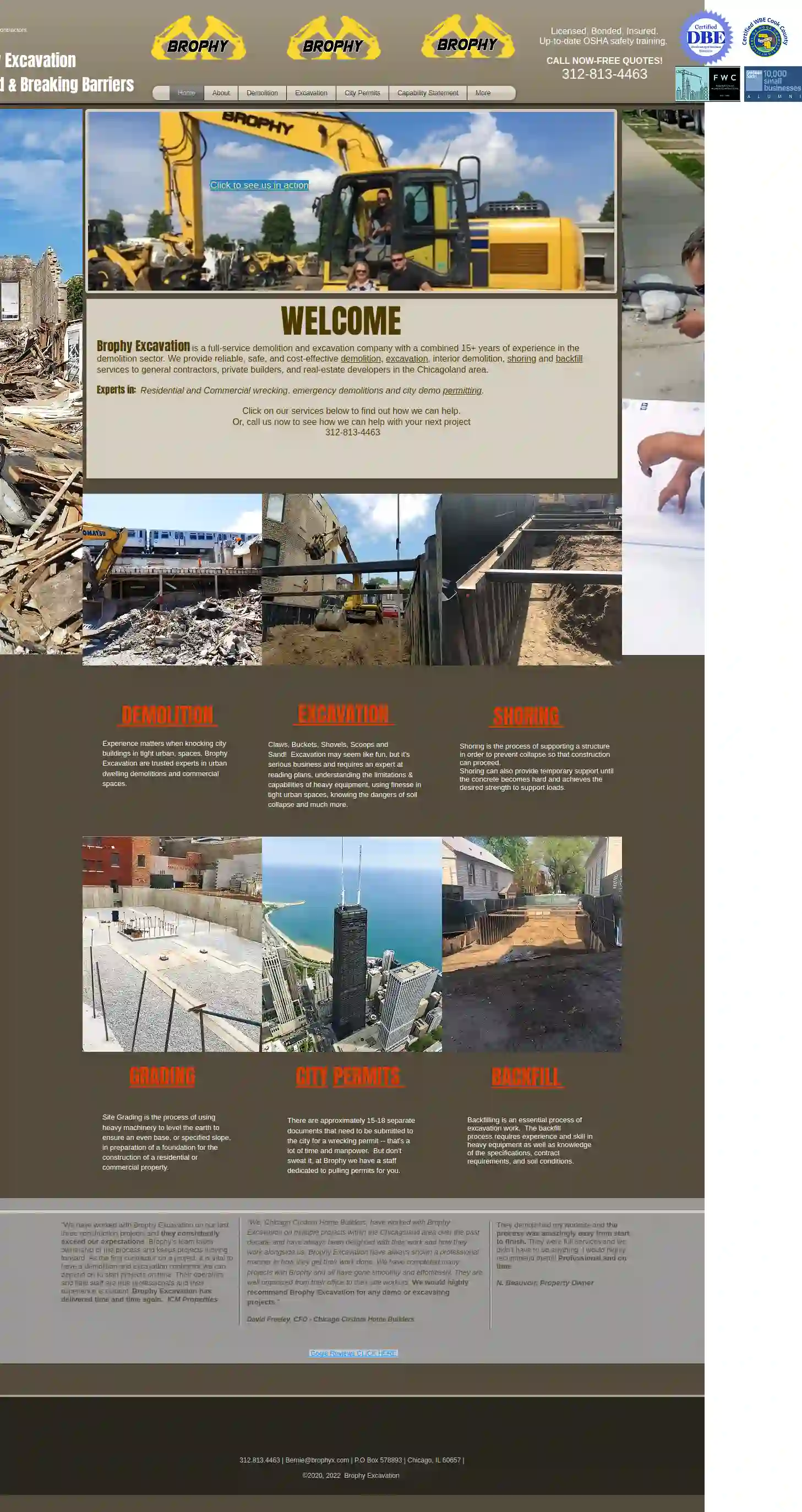
Brophy Excavation-Demolition
4.86 reviewsP.O Box 578893, Chicago, 60657, USBrophy Excavation: Your Trusted Partner for Demolition and Excavation in Chicago Brophy Excavation is a full-service demolition and excavation company with over 15 years of experience in the Chicagoland area. We provide reliable, safe, and cost-effective services to general contractors, private builders, and real estate developers. Our team of experts is dedicated to delivering exceptional results on every project, no matter how big or small. We specialize in: Residential and Commercial Wrecking Emergency Demolitions City Demo Permitting Excavation Shoring Grading Backfill At Brophy Excavation, we understand the importance of safety and efficiency. We are fully licensed, bonded, and insured, and our team is up-to-date on all OSHA safety training. We are committed to providing our clients with the highest level of service and professionalism. Contact us today for a free quote and let us help you with your next project.
- Services
- Why Us?
- Testimonials
- Gallery
Get Quote- Ry
Ryan Excavating
51 reviewsChicago, USFacebook is a social networking service and website launched in February 2004, owned by Meta Platforms. It is the largest social network in the world, with over 2.91 billion monthly active users as of the first quarter of 2023. Users can create a personal profile, add other users as friends, and exchange messages, photos, and videos. Facebook is also used by businesses to connect with customers and promote their products and services. The site has been criticized for its role in the spread of misinformation, its impact on mental health, and its privacy practices.
- Services
- Why Us?
- Gallery
Get Quote 
John Keno & Co
4.19 reviews8623 W Bryn Mawr Ave., Chicago, 60631, USJKC Overview Since 1946, John Keno & Company has provided world-class site preparation, excavating and shoreline development services throughout Chicagoland and along the shores of Lake Michigan. We are a third-generation, veteran-owned company with a deep commitment to safety, quality, and customer satisfaction. Our team of experienced professionals is dedicated to providing our clients with the highest level of service and expertise. Our Values Our values are the foundation of our success. We are committed to: World-class performance Serving as an excavation extension of your team Harnessing new technology to solve more problems
- Services
- Why Us?
- Gallery
Get Quote
Over 22,076+ Excavation Companies on our directory
Our excavation companies operate in Minooka & beyond!
ExcavationHQ has curated and vetted the Best Excavation Pros in and around Minooka. Find the most reliable contractor today.
Frequently Asked Questions About Demolition Contractors
- Site Security: Secure the demolition site with fencing and warning signs to prevent unauthorized access.
- Personal Protective Equipment (PPE): Workers should wear appropriate PPE, including hard hats, safety glasses, gloves, and steel-toe boots.
- Hazardous Material Removal: Properly identify and remove asbestos, lead paint, or other hazardous materials before demolition begins.
- Utility Disconnections: Disconnect all utilities, such as electricity, gas, and water, before demolition.
- Controlled Demolition Techniques: Employ controlled demolition methods to minimize risks and ensure the structure comes down safely.
- Dust Control: Implement dust suppression measures, such as water spraying or misting, to reduce airborne particles and protect air quality.
- Emergency Planning: Have an emergency plan in place, including communication protocols and evacuation procedures, in case of unforeseen events.
- 'Can I see proof of your licensing and insurance?' Verify their credentials and coverage.
- 'What experience do you have with projects like mine?' Ensure they have relevant expertise.
- 'Can you provide references from past clients?' Check their reputation and customer satisfaction.
- 'What are your safety protocols?' Prioritize contractors who emphasize safety.
- 'How will you handle hazardous materials?' Ensure they have proper procedures for asbestos or lead abatement.
- 'What is your timeline for completing the project?' Understand the project duration.
- 'How will you manage noise, dust, and debris?' Discuss mitigation measures for minimizing disruption.
- 'What are your payment terms?' Clarify payment schedules and any required deposits.
How can I tell if my building contains asbestos?
What are the safety precautions for demolition?
How do I find demolition contractors near me?
What questions should I ask a demolition contractor before hiring them?
How can I tell if my building contains asbestos?
What are the safety precautions for demolition?
- Site Security: Secure the demolition site with fencing and warning signs to prevent unauthorized access.
- Personal Protective Equipment (PPE): Workers should wear appropriate PPE, including hard hats, safety glasses, gloves, and steel-toe boots.
- Hazardous Material Removal: Properly identify and remove asbestos, lead paint, or other hazardous materials before demolition begins.
- Utility Disconnections: Disconnect all utilities, such as electricity, gas, and water, before demolition.
- Controlled Demolition Techniques: Employ controlled demolition methods to minimize risks and ensure the structure comes down safely.
- Dust Control: Implement dust suppression measures, such as water spraying or misting, to reduce airborne particles and protect air quality.
- Emergency Planning: Have an emergency plan in place, including communication protocols and evacuation procedures, in case of unforeseen events.
How do I find demolition contractors near me?
What questions should I ask a demolition contractor before hiring them?
- 'Can I see proof of your licensing and insurance?' Verify their credentials and coverage.
- 'What experience do you have with projects like mine?' Ensure they have relevant expertise.
- 'Can you provide references from past clients?' Check their reputation and customer satisfaction.
- 'What are your safety protocols?' Prioritize contractors who emphasize safety.
- 'How will you handle hazardous materials?' Ensure they have proper procedures for asbestos or lead abatement.
- 'What is your timeline for completing the project?' Understand the project duration.
- 'How will you manage noise, dust, and debris?' Discuss mitigation measures for minimizing disruption.
- 'What are your payment terms?' Clarify payment schedules and any required deposits.